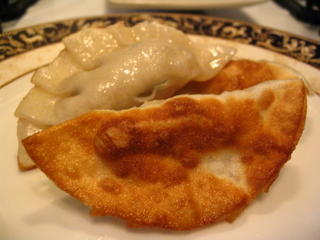
For my 101st post, I am posting my entry to Meena's "From My Rasoi - Winter" blogging event. I've chosen an original recipe that I call Bengali Dal (even though it is not made with Bengal gram), which is the perfect kind of warming, comforting food to have during the long, comforting food to have during the long, chilly months of winter.
The red lentils don't take long to cook, and the warmth of the mustard seed oil combined with the creaminess of a small amount of coconut milk makes this a wonderful counterpoint to the flavours of cumin, chiles, garlic and curry. The little dark specks are brown mustard seed and nigella seed, the red is finely diced tomato, and the green is sliced chiles. You can vary the amount of chiles to make it as spicy or mild as you like, but naturally I like it spicy. There is a little dried fenugreek stirred into the dish at the last minute, which makes a sudden, compelling fragrance that will pull people into the kitchen.
Bengali Dal
Serves 6 - 8
Total prep and cooking time: 40 minutes unless you're super-efficient and/or have kitchen helpers. Then, maybe 25 - 30.
1 1/2 cups of red lentils (masur dal)
4 1/2 cups of water
3/4 teaspoon turmeric powder
1/2 teaspoon ground cumin
1/2 teaspoon curry powder (optional)
1 1/2 teaspoons sambal oelek
1 clove garlic, minced
2–3 jalapeños, seeded and chopped
1 small can coconut milk - 2/3 cup, approx.
1 teaspoon salt
Tempering:
1 teaspoon mustard oil
1 teaspoon nigella seed (kalonji)
1 teaspoon brown/black mustard seeds
1 medium onion, diced medium
1 clove garlic, sliced
1 large tomato, seeded and diced
Finishing:
salt to taste
big pinch of fenugreek leaves
Pick over lentils to remove misshapen, discoloured or otherwise irregular lentils and any foreign matter (little rocks, plant stems, etc). Rinse thoroughly, with several changes of water to remove any grit or dust (very important).
Place lentils in a heavy pot with the water and the turmeric and bring to a boil. Reduce the heat to a medium-low simmer, and skim the yellow foam from the top. Allow to simmer until lentils are tender and starting to fall apart – 15 minutes or a bit more, if you have older lentils. Add the jalapeños, crushed garlic, spices and the coconut milk and continue to simmer (with the lid off, stirring occasionally) and get thick while you prepare the tempering.
In a small, nonstick skillet, heat oil gently over medium heat. Add nigella seed and mustard seed, giving the pan a shake to distribute. As soon as the mustard seeds start to pop, add the onions and sliced garlic and fry gently until they have softened. Next, add the diced tomatoes, and stir until they give up their liquid - often they turn the onions a pretty golden colour - and scrape the mixture into the lentil pottage. Use a spatula to get out all the spicy goodness! Taste and adjust for salt to your preference and stir in the fenugreek leaves just before serving.

I am happy to serve this over rice as a meal unto itself, or as part of a larger menu. It freezes and reheats extraordinarily well, which makes it the perfect thing to make lots of, and tuck away the leftovers in the fridge for one of those harrowing days when you need a little home made comfort, but haven't the energy or nerves to do more than heat something up. It also travels well to work or school and is vegan, although I am not.








